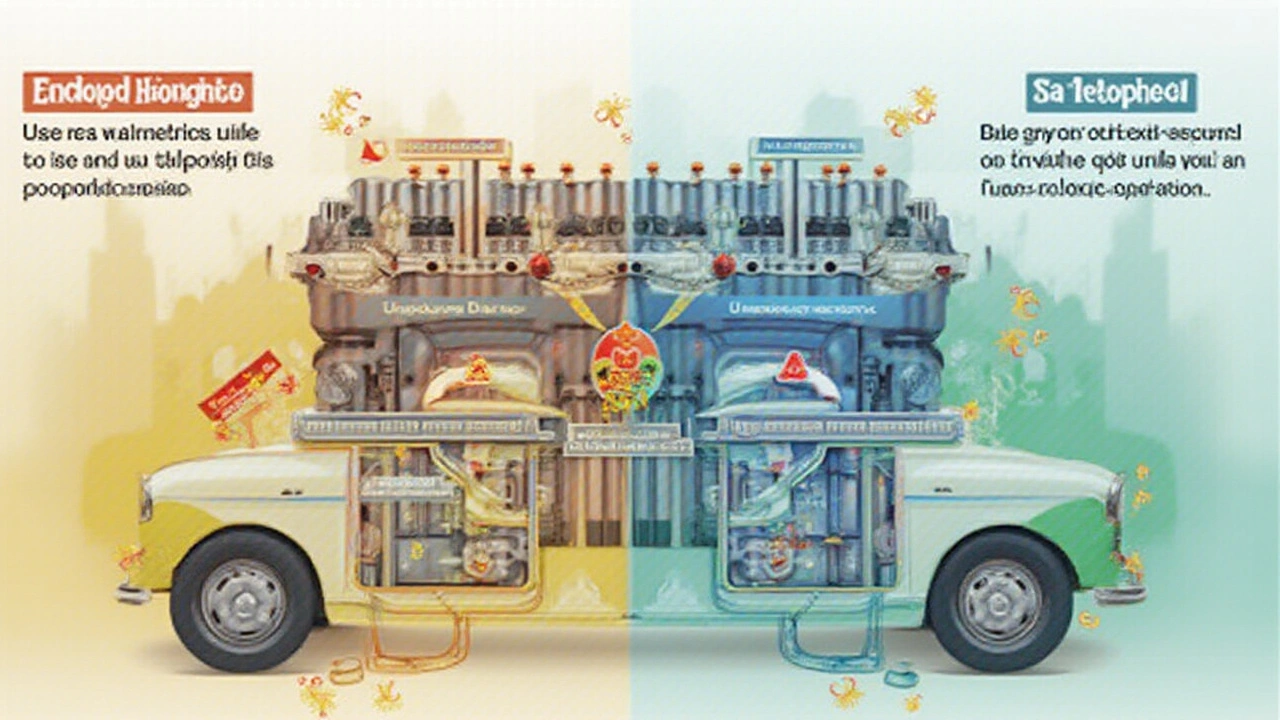Pop open a hood anywhere in 2025, and odds are high you’ll spot a bottle of synthetic oil in the garage. Its slick marketing promises better protection, longer engine life, fewer oil changes, world peace—well, maybe not that last one. But here’s the twist: synthetic oil isn’t a magic fix-all. Dropping it into the wrong engine can do harm, cause leaks, or empty your wallet faster than that V8 empties its tank. Seriously.
There’s a growing crowd asking, “Is synthetic always better?” Sure, it’s tough and stable under heat. But is it always a good fit? Not a chance. Some engines were never built for it. Others actually run smoother on old-school conventional oil. Still skeptical? Let’s peel back the glossy label and reveal what really happens if you use synthetic oil where you shouldn’t. There’s more at stake than you might think.
Why Synthetic Oil Isn’t Right for Every Engine
It seems almost rebellious to say synthetic oil has any downsides, given how much it’s pushed in car shops today. Yet, the reality is much less black and white. The most obvious case against synthetic oil is sitting in your neighborhood’s next Sunday car meetup—classic cars built decades ago. These beauties just weren’t designed with today’s high-tech lubricants in mind.
Engines from the 1950s to early ‘80s feature gaskets and seals made from materials like cork, rope, or early rubber blends. Synthetic oil flows smoothly—sometimes too smoothly. It’ll slip right through small gaps or dried seals, leading to leaks. If you ever spot an older Chevy Bel Air with drips under its chassis after a synthetic oil change, that’s probably why. The owner may even share a few choice words about “modern snake oil.”
And then there’s the matter of ZDDP (zinc dialkyldithiophosphate). Sounds like a chemistry class buzzword, but for older flat tappet camshaft designs, it’s the secret sauce. ZDDP boosts wear protection. Most synthetic oils today are formulated for modern engines, which use roller cams or have lower ZDDP needs. Pouring these modern synthetics into an old muscle car’s engine can spell rapid camshaft wear. There’s documented evidence: a study presented by the American Petroleum Institute in 2018 found that certain older engines showed up to a 40% increase in cam lobe wear when ZDDP-deficient synthetic was used.
Mismatched oil viscosity is another dealbreaker. Not all engines want the same grade. Some older or specialty engines call for heavier oils—think 20W-50—to maintain oil pressure and cushion loose tolerances. Synthetic oils in thinner grades, like 0W-20, can simply be too slippery. If you’re running a 1982 Harley or a high-mileage ‘76 Ford pickup, using the wrong-grade synthetic risks knocking, noisy operation, and even accelerated wear.
Extreme cold? Synthetic oils shine in cold starts, but certain engines—usually older diesels or ones with simple oiling systems—may fail to keep the right pressure with synthetic’s lower viscosity. This can cause lifter noise, ticking, or even failures. You’ll find plenty of firsthand accounts on classic auto forums where switching back to a conventional blend cured odd engine noises that arrived with synthetic oil.
Cost is a practical dealbreaker some folks ignore. If you’re driving a beat-up work truck with 250,000 miles that leaks or burns oil, using high-end synthetic can feel like pouring money down a drain. In situations where you’re topping up every time you fill the gas tank, premium oil isn’t buying you any extra peace of mind. It just vanishes into the combustion chamber or the roadside gutter.
Even motorcycles and high-performance small engines, like those in certain lawn equipment, can push back against synthetic. Some manufacturer warranties specify avoiding synthetic oil during engine break-in periods. This is because synthetic oil is so good at reducing friction it can actually prevent proper seating of rings and bearings when the metal needs some roughness to “bed in.” Owners of new performance bikes should actually check the manual, not just the oil ad claims.
Here’s an odd twist: certain hybrids and small-displacement turbo engines rely on quick oil flow and tailored additive packs. Using a generic full synthetic not made for hybrids or turbocharged engines could starve crucial turbo bearings of protection or leave hybrid valves dirty, which chip away at efficiency. These engines aren’t always anti-synthetic, but they do need the exact right synthetic—so the “one size fits all” idea doesn’t work here.
| Engine Type | Recommended Oil Type | Risk of Synthetic Oil |
|---|---|---|
| Pre-1980 Classic | Conventional 10W-40+ with high ZDDP | Leaks, increased wear, cam/lifter damage |
| High-Mileage (>200k) with Leaks | Conventional, Leak-Reducing Blend | Increased oil consumption, wasted cost |
| Fresh-Built Engines | Conventional for Break-In | Improper seating of rings/bearings |
| Turbo Hybrids | Synthetic specified by OEM | Turbo wear if wrong blend |

When Your Car Manual Says No: Trust or Ignore?
This is the part people love to debate at auto parts stores: should you listen to your owner’s manual or trust the newest YouTube “oil test”? Truth is, most owner’s manuals get their update cycles every 4-6 years, but car engine designs live longer than that. If your car manual says not to use synthetic oil (or specifies a particular type), that’s not some legal disclaimer—it’s based on the actual design of your block, valvetrain, and oiling system.
Many European automakers like BMW, Mercedes, or Audi began requiring synthetic oil for certain high-compression engines right from the early 2000s. But older American brands—think Chevy, Dodge, or Ford before the early 1990s—rarely tested their gaskets or seals for ultra-slick synthetics. Look at the technical bulletins from GM in the early 2000s. They warned that using synthetic in some old 350-cubic-inch V8 engines could cause seal shrinkage and leaks. Now, if your manual is sitting in the glovebox, check oil requirements. If it calls for something like “API SL rated 10W-30,” that means it was designed for conventional, not synthetic.
And then there’s warranty coverage. If your car is new enough that the drivetrain warranty still applies, deviating from specified oil type is asking for denied claims if anything goes wrong. Toyota, as late as 2017, had cases where using unapproved synthetic voided powertrain warranty even if the oil was technically “better.” The paperwork matters—one simple typo with an oil receipt can turn a broken engine into your problem, not theirs.
Some people argue that “synthetic blends” (where conventional oil is mixed with synthetic) are the best of both worlds. This can help, but certain hybrids of old and new don’t always play nice together. Key ingredients in synthetic blends can still attack old seals or reduce the friction needed for break-in. If you’re tempted to experiment, talk to a well-reviewed local mechanic—not just the kid behind the counter at the big-box parts store.
It’s also worth pointing out that not all synthetics are created equal. Group IV and V base oils—the “real” full synthetics—are chemically engineered, while Group III is technically a highly processed mineral oil. Some car forums are lit up with debates on this. Brands like Mobil 1 and Castrol have both shifted formulations in recent years. If you’re strict about classic car care, you need full chemical synthetic, which can be harder to find and costs more.
Curious about your older car’s specific compatibility? Here’s a hack: Call or email the original manufacturer tech support, or check reputable enthusiast forums for your engine. There are a few websites that post scanned versions of old service bulletins, which detail exactly how certain engines handle synthetic oil.
Remember: just because modern high-performance engines love synthetic doesn’t mean your daily driver from 1984 will thank you for it. Even if synthetic protects better at the molecular level, it won’t resurrect worn-out seals or undo high-mileage quirks. That’s why, for certain engines, good old dino juice (conventional oil) is the wise pick.

Tips for Choosing the Right Oil for Your Engine’s Needs
Wading through oil choices isn’t just for gearheads or mechanics. Your engine’s future—and your wallet—depend on these choices. If you drive an older car, check for leaks around seals, the oil pan, or valve covers. If the driveway looks like a Rorschach test, synthetic oil might just make things worse. Stick to a conventional or “high-mileage” oil, which usually has seal conditioners that help slow leaks in old gaskets.
If your car uses a flat tappet camshaft (most pre-1990 performance engines do), get an oil with higher ZDDP content. You can’t rely on most off-the-shelf synthetics, because regulators forced automakers to cut ZDDP for environmental reasons. But brands like Valvoline VR1 or Lucas Hot Rod Oil are blended specifically for classics and state their ZDDP level on the bottle.
Got a modern engine or hybrid with a turbo? Use synthetic, but not just any bottle with “synthetic” slapped on the label. Find one meeting the exact API or ACEA spec in your car’s owner’s manual. Oils with the wrong additive packs can leave deposits or cause “low speed pre-ignition” (LSPI)—a serious concern for turbo engines. In 2020, Ford issued technical service bulletins on LSPI for their EcoBoost engines, linked to using the wrong oil blend.
During engine break-in on new or rebuilt units, avoid synthetic oil until at least the first scheduled change. Most engine builders recommend running a quality conventional oil for the first 500 to 1,000 miles, letting the rings seat and bearings settle. Then, if you switch, double-check for leaks and proper oil pressure. Some high-end builds never use synthetic—especially in drag racing, where stickier oil helps maintain tight clearances under brutal acceleration.
Here’s a smart routine for DIYers who want to experiment: If you want to see if your engine tolerates synthetic, do a thorough inspection first for gasket wear and leaks. Make the switch, and after 500–1,000 miles, inspect for leaks, oil consumption, and odd noises. If anything’s off, swap back fast. There's no shame in using what works, hype aside.
Keen on data? Oil analysis labs offer cheap testing (about $30 bucks as of 2025). Send in a sample after switching to synthetic. The lab will tell you if you’re seeing excessive wear metals—an early warning to return to conventional. Truckers have used these reports for decades to keep engines running strong for a million miles or more.
Biking or mowing with a small engine? Go straight to the maker’s website. Some Honda and Briggs & Stratton models still say “No” to full synthetics, especially on first start-up. Small engines without oil filters especially need exactly what the manual says, or risk shortening their life—these engines can’t cost-effectively be rebuilt the way car engines can.
If cost is an issue (who isn’t tight with money?), remember: doubling your oil change interval by using synthetic rarely saves cash if your engine leaks or burns oil. Instead, spend your budget on fixing the underlying problem first—fresh seals, gaskets, PCV valves, and so on. Then, once your engine is healthy, synthetic oil might actually deliver on its promises.
And don’t forget: engines are like people. Some like the cutting-edge stuff, while others feel best old school. Modern sports cars, turbocharged monsters, and high-revving motorcycles love synthetic—it lets them run fast, hot, and long. But vintage rides, high-mileage beaters, and quirky hybrids often just want what they were born with. synthetic oil is great—when it’s the right fit. If not, don’t believe the hype. Your engine will thank you.

